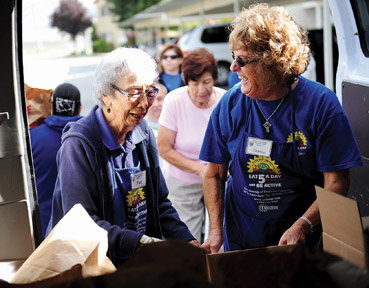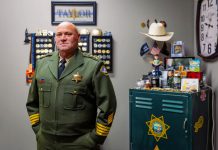
Senior volunteers fill needs at many local agencies
When Donna Berlin and Sue Wharton arrived at the Villa
Apartments on Prospect Avenue in the white Community Pantry van
late Monday morning, seniors quickly lined up to receive a bag of
food.
Berlin has been volunteering with Community Food Bank (formerly
Community Pantry) for 12 years while Sue has been volunteering for
at least 10 years. They are both retired and seniors themselves,
but they give their time every Wednesday morning for the senior
distribution, and once a month on Monday for the USDA
distribution.
”
The satisfaction of giving back to the community
”
is what keeps Berlin volunteering.
Senior volunteers fill needs at many local agencies
When Donna Berlin and Sue Wharton arrived at the Villa Apartments on Prospect Avenue in the white Community Pantry van late Monday morning, seniors quickly lined up to receive a bag of food.
Berlin has been volunteering with Community Food Bank (formerly Community Pantry) for 12 years while Sue has been volunteering for at least 10 years. They are both retired and seniors themselves, but they give their time every Wednesday morning for the senior distribution, and once a month on Monday for the USDA distribution.
“The satisfaction of giving back to the community” is what keeps Berlin volunteering.
Berlin and Wharton are just two of the 525 volunteers registered locally with the Retired Senior Volunteer Program, or RSVP, a national organization that works to connect seniors with opportunities at nonprofit or government agencies.
Regina Henderson is the outreach coordinator for San Benito, Santa Cruz and Monterey counties. The main goal of RSVP is to connect seniors with volunteer opportunities. But those who are already volunteering may also benefit from joining RSVP. The program sends out a quarterly newsletter that highlights volunteers and opportunities to serve in the community. They host a brunch once a year to show appreciation for the volunteers. They also track the number of hours the seniors spend in their communities.
And though it’s a small amount, Henderson said the program offers an incentive of $10 a month, paid out quarterly, to cover gas mileage to the volunteer sites.
Year-to-date, the volunteers in the three counties have worked 232,799 hours for 125 agencies.
“It’s really an amazing thing,” Henderson said. “It’s really important that the hours are calculated so the powers that be see it. It is everything from Big Brothers – working with kids – or reading at libraries, or working with animals at shelters.”
Henderson said the volunteers themselves enjoy the mental and physical benefits of getting out.
“It is a real health benefit to get out and want to be with people,” Henderson said. “By them working with us, our community gets to be nourished by all their lifelong experiences.”
The members do not necessarily have to be retired to join, but they have to be 55 or older. Henderson said more of the baby-boomer generation are still working and volunteering on the side, while some of those who are fully retired may work for multiple agencies.
Berlin retired 14 years ago from Spring Grove School, where she supervised in the kitchen. She had volunteered as a teacher’s aides while her children were in school and became a paid aide before moving on to the kitchen.
“I enjoyed working with the school district,” she said. “I enjoyed working with kids as well as I do enjoy working with seniors – except I am one now.”
Berlin volunteers at Community Food Bank and at Pat’s Place, the thrift shop that raises money for the food bank. She also volunteers with the Hazel Hawkins Hospital Auxiliary and Hazel’s thrift shop. She and her husband, Bill, work to install emergency response units for seniors in San Benito County as well.
The pair installs the units through Companion for Life/Lifeline Project, a nonprofit program for homebound or disabled seniors, which provides the emergency response equipment and monitoring on a month-to-month basis. The seniors are given a pendant or a wristband that has a button that can be pressed in an emergency. The calls are routed to a pre-determined emergency contact. There is a charge for the installation and the monthly service, but there is a sliding scale available for low-income seniors. More information can be found by calling 475-2778.
Berlin said the number of calls they receive varies from month to month.
Though Berlin found most of her volunteer opportunities on her own, she promotes RSVP to others.
“I found out about it by working with people who belonged to RSVP,” she said. “I just think it is a wonderful thing that they can hook seniors up with something to do to make their time a little bit more worthwhile.”
On the morning of the USDA food handout, Wharton and Berlin joked with the seniors who waited in line for their bags. The two handled boxes of hamburger meat and shredded cheddar cheese with ease as they added the packages of each product to bags from the Community Food Bank.
Wharton used to work for RSVP as an outreach coordinator and said she enjoys volunteering now that she has retired.
“Just as far as I’m concerned, I love to help other people by getting food to them,” she said, “and getting to meet people and have fun.”
Sonja and Louis Melchor also find meeting people as one of the most rewarding parts of their volunteer work. The two, who reside in Milpitas, are docents at the San Juan Bautista State Historic Park. At least once a month they drive down for events such as Living History Days.
“We like to go to historical parks and we were wandering around and one day there were some docents,” Sonja said. “We went in and talked to the ranger at the time and they told us about the docent program.”
The two often make a trip of it, driving down in their RV and camping at Casa de Fruta for a few days, unless the weather is bad.
The two learned about RSVP when Henderson came to one of the annual meetings and explained the benefits.
“They give you a small mileage per month,” Sonja said. “They help us and we help them by turning our hours in.”
Louis was reluctant to sign up as a docent at first, but the two attended training sessions on Saturdays and have now been working as docents for almost four years.
“I basically explain the buildings, dressed in period costume,” Sonja said. “I have something like crocheting or sewing or some activity that was done then.”
She and another docent sometimes do laundry in a tub and hang it out to dry, depending on the weather. She said she and Louis have met people from all over the world who visit the Mission city, from countries such as Germany, France and Ecuador.
“The people are the rewarding experience,” she said. “There is a lot of camaraderie among the docents. That’s a nice thing.”
Louis said he has created a couple of characters that he portrays during the living history events, including one he calls Chicken George, in honor of all the chickens in San Juan Bautista.
“I love to intermingle with the folks that come through the park and talking to them,” he said. “I also like to interact with the other docents. Some of us guys, we do the history part, and throw some humor into it.”
He said he works in the saloon, selling sarsaparilla and root beer.
“It’s a common ground when (visitors) ask a question or when you talk about the artifacts that are there in front of you,” he said.
Join RSVP
For more information on the Retired Seniors Volunteer Program, visit http://www.seniorcorps.gov/about/programs/rsvp.asp. To find local volunteer opportunities or to join, call Regina Henderson at 427-5070 or e-mail her at re****@***************er.org.









